NURSING. NURSING Name of the Student: Name of the Unive
VerifiedAdded on 2023/03/23
|10
|3132
|35
AI Summary
Contribute Materials
Your contribution can guide someone’s learning journey. Share your
documents today.
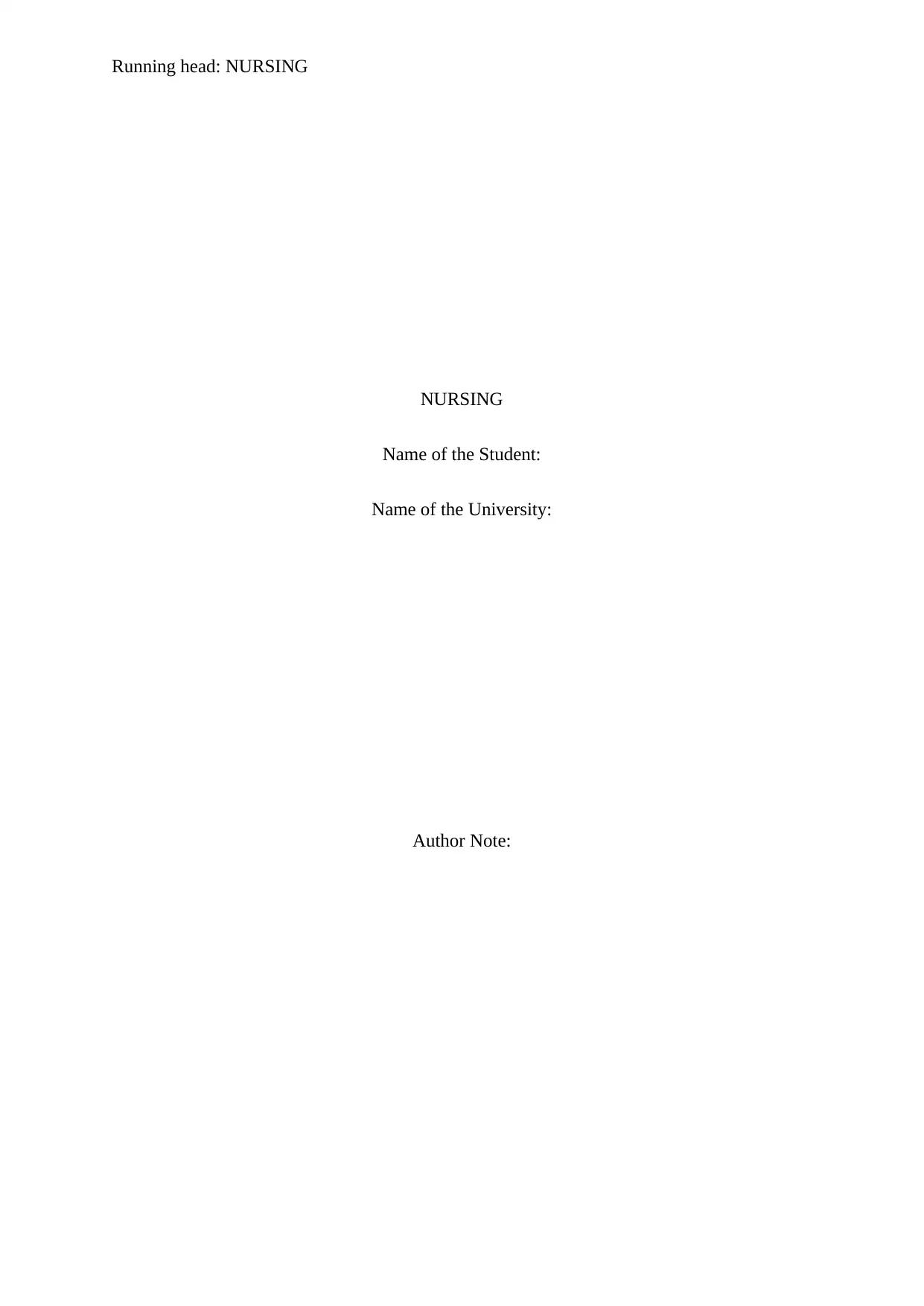
Running head: NURSING
NURSING
Name of the Student:
Name of the University:
Author Note:
NURSING
Name of the Student:
Name of the University:
Author Note:
Secure Best Marks with AI Grader
Need help grading? Try our AI Grader for instant feedback on your assignments.
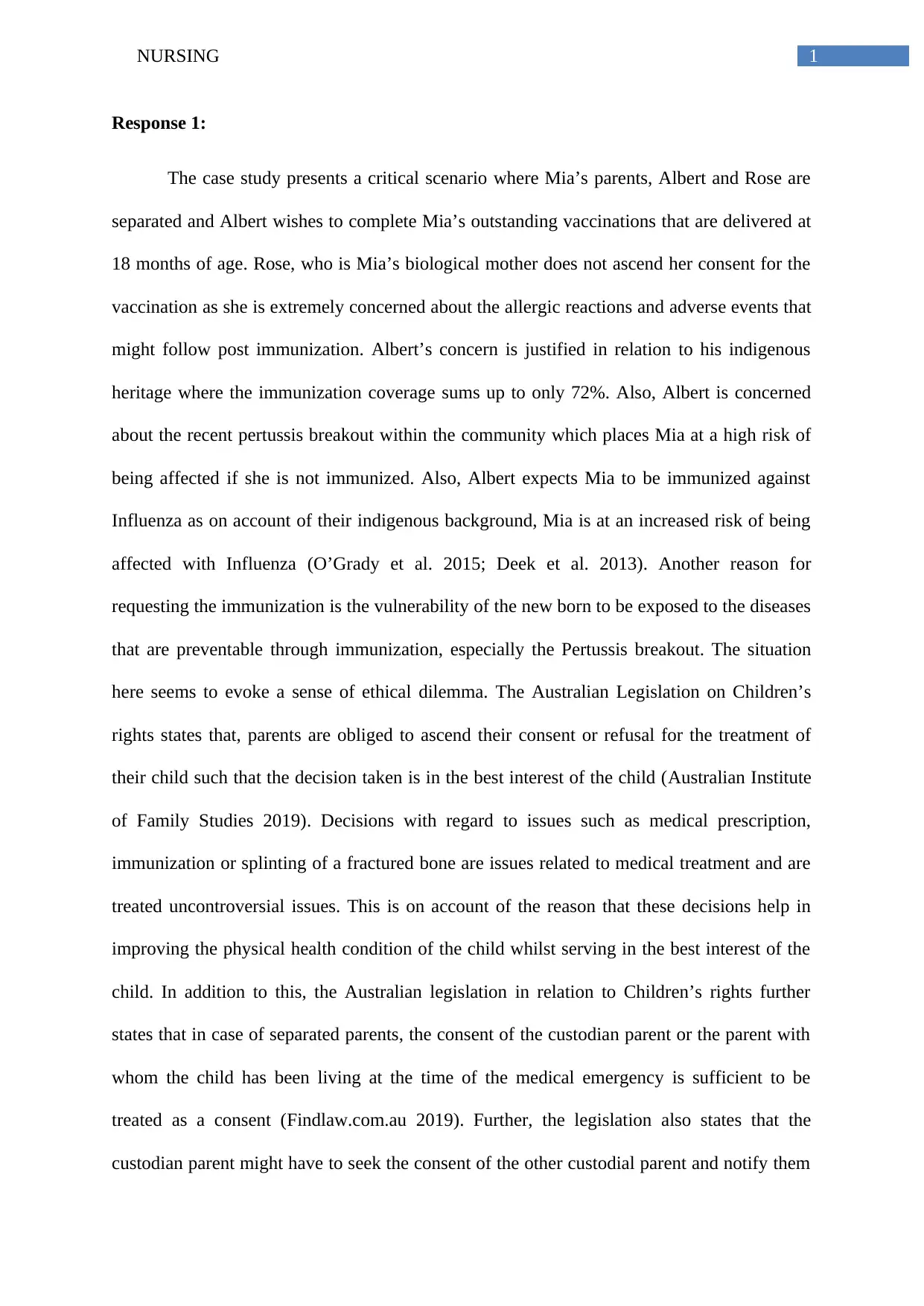
1NURSING
Response 1:
The case study presents a critical scenario where Mia’s parents, Albert and Rose are
separated and Albert wishes to complete Mia’s outstanding vaccinations that are delivered at
18 months of age. Rose, who is Mia’s biological mother does not ascend her consent for the
vaccination as she is extremely concerned about the allergic reactions and adverse events that
might follow post immunization. Albert’s concern is justified in relation to his indigenous
heritage where the immunization coverage sums up to only 72%. Also, Albert is concerned
about the recent pertussis breakout within the community which places Mia at a high risk of
being affected if she is not immunized. Also, Albert expects Mia to be immunized against
Influenza as on account of their indigenous background, Mia is at an increased risk of being
affected with Influenza (O’Grady et al. 2015; Deek et al. 2013). Another reason for
requesting the immunization is the vulnerability of the new born to be exposed to the diseases
that are preventable through immunization, especially the Pertussis breakout. The situation
here seems to evoke a sense of ethical dilemma. The Australian Legislation on Children’s
rights states that, parents are obliged to ascend their consent or refusal for the treatment of
their child such that the decision taken is in the best interest of the child (Australian Institute
of Family Studies 2019). Decisions with regard to issues such as medical prescription,
immunization or splinting of a fractured bone are issues related to medical treatment and are
treated uncontroversial issues. This is on account of the reason that these decisions help in
improving the physical health condition of the child whilst serving in the best interest of the
child. In addition to this, the Australian legislation in relation to Children’s rights further
states that in case of separated parents, the consent of the custodian parent or the parent with
whom the child has been living at the time of the medical emergency is sufficient to be
treated as a consent (Findlaw.com.au 2019). Further, the legislation also states that the
custodian parent might have to seek the consent of the other custodial parent and notify them
Response 1:
The case study presents a critical scenario where Mia’s parents, Albert and Rose are
separated and Albert wishes to complete Mia’s outstanding vaccinations that are delivered at
18 months of age. Rose, who is Mia’s biological mother does not ascend her consent for the
vaccination as she is extremely concerned about the allergic reactions and adverse events that
might follow post immunization. Albert’s concern is justified in relation to his indigenous
heritage where the immunization coverage sums up to only 72%. Also, Albert is concerned
about the recent pertussis breakout within the community which places Mia at a high risk of
being affected if she is not immunized. Also, Albert expects Mia to be immunized against
Influenza as on account of their indigenous background, Mia is at an increased risk of being
affected with Influenza (O’Grady et al. 2015; Deek et al. 2013). Another reason for
requesting the immunization is the vulnerability of the new born to be exposed to the diseases
that are preventable through immunization, especially the Pertussis breakout. The situation
here seems to evoke a sense of ethical dilemma. The Australian Legislation on Children’s
rights states that, parents are obliged to ascend their consent or refusal for the treatment of
their child such that the decision taken is in the best interest of the child (Australian Institute
of Family Studies 2019). Decisions with regard to issues such as medical prescription,
immunization or splinting of a fractured bone are issues related to medical treatment and are
treated uncontroversial issues. This is on account of the reason that these decisions help in
improving the physical health condition of the child whilst serving in the best interest of the
child. In addition to this, the Australian legislation in relation to Children’s rights further
states that in case of separated parents, the consent of the custodian parent or the parent with
whom the child has been living at the time of the medical emergency is sufficient to be
treated as a consent (Findlaw.com.au 2019). Further, the legislation also states that the
custodian parent might have to seek the consent of the other custodial parent and notify them
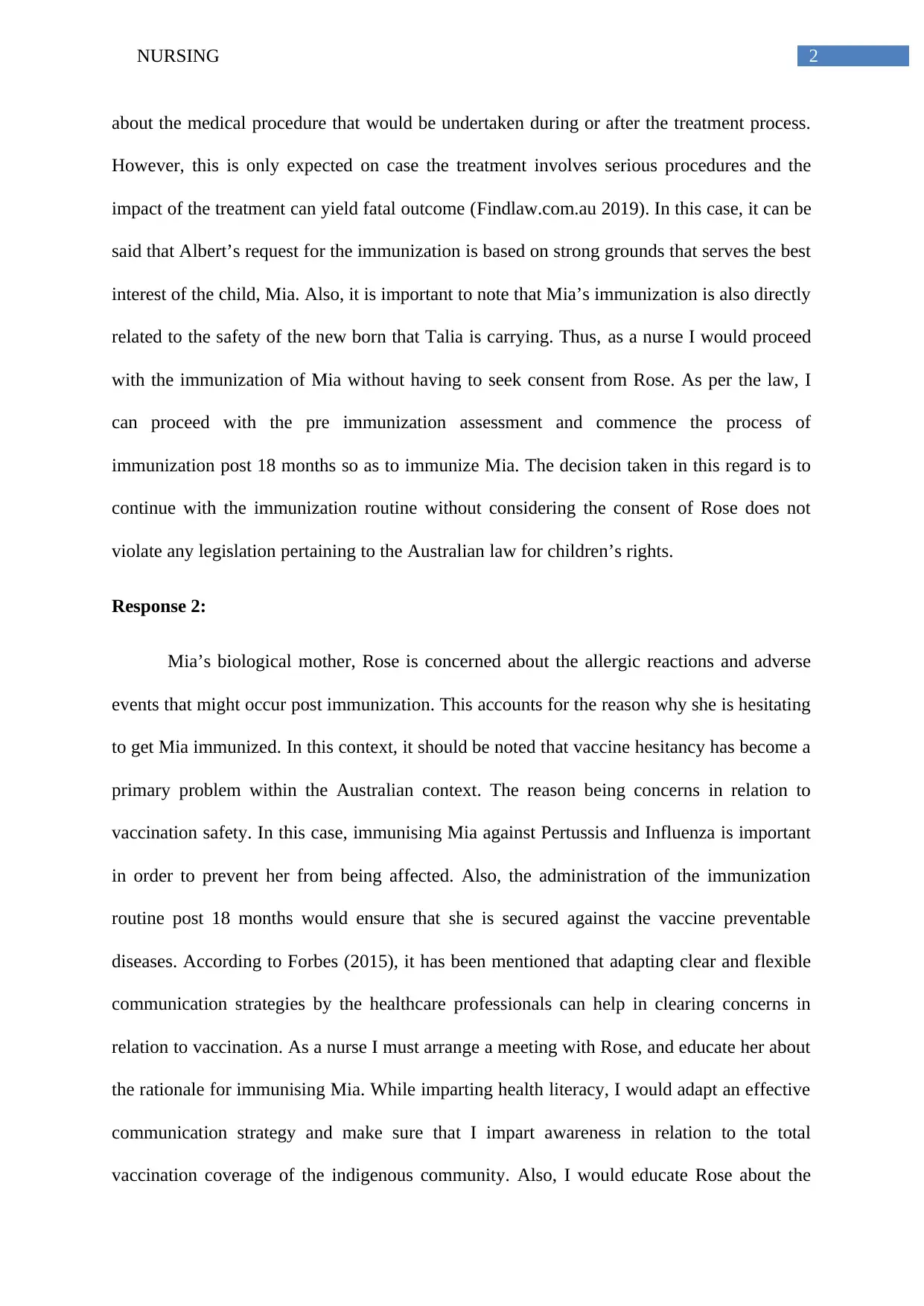
2NURSING
about the medical procedure that would be undertaken during or after the treatment process.
However, this is only expected on case the treatment involves serious procedures and the
impact of the treatment can yield fatal outcome (Findlaw.com.au 2019). In this case, it can be
said that Albert’s request for the immunization is based on strong grounds that serves the best
interest of the child, Mia. Also, it is important to note that Mia’s immunization is also directly
related to the safety of the new born that Talia is carrying. Thus, as a nurse I would proceed
with the immunization of Mia without having to seek consent from Rose. As per the law, I
can proceed with the pre immunization assessment and commence the process of
immunization post 18 months so as to immunize Mia. The decision taken in this regard is to
continue with the immunization routine without considering the consent of Rose does not
violate any legislation pertaining to the Australian law for children’s rights.
Response 2:
Mia’s biological mother, Rose is concerned about the allergic reactions and adverse
events that might occur post immunization. This accounts for the reason why she is hesitating
to get Mia immunized. In this context, it should be noted that vaccine hesitancy has become a
primary problem within the Australian context. The reason being concerns in relation to
vaccination safety. In this case, immunising Mia against Pertussis and Influenza is important
in order to prevent her from being affected. Also, the administration of the immunization
routine post 18 months would ensure that she is secured against the vaccine preventable
diseases. According to Forbes (2015), it has been mentioned that adapting clear and flexible
communication strategies by the healthcare professionals can help in clearing concerns in
relation to vaccination. As a nurse I must arrange a meeting with Rose, and educate her about
the rationale for immunising Mia. While imparting health literacy, I would adapt an effective
communication strategy and make sure that I impart awareness in relation to the total
vaccination coverage of the indigenous community. Also, I would educate Rose about the
about the medical procedure that would be undertaken during or after the treatment process.
However, this is only expected on case the treatment involves serious procedures and the
impact of the treatment can yield fatal outcome (Findlaw.com.au 2019). In this case, it can be
said that Albert’s request for the immunization is based on strong grounds that serves the best
interest of the child, Mia. Also, it is important to note that Mia’s immunization is also directly
related to the safety of the new born that Talia is carrying. Thus, as a nurse I would proceed
with the immunization of Mia without having to seek consent from Rose. As per the law, I
can proceed with the pre immunization assessment and commence the process of
immunization post 18 months so as to immunize Mia. The decision taken in this regard is to
continue with the immunization routine without considering the consent of Rose does not
violate any legislation pertaining to the Australian law for children’s rights.
Response 2:
Mia’s biological mother, Rose is concerned about the allergic reactions and adverse
events that might occur post immunization. This accounts for the reason why she is hesitating
to get Mia immunized. In this context, it should be noted that vaccine hesitancy has become a
primary problem within the Australian context. The reason being concerns in relation to
vaccination safety. In this case, immunising Mia against Pertussis and Influenza is important
in order to prevent her from being affected. Also, the administration of the immunization
routine post 18 months would ensure that she is secured against the vaccine preventable
diseases. According to Forbes (2015), it has been mentioned that adapting clear and flexible
communication strategies by the healthcare professionals can help in clearing concerns in
relation to vaccination. As a nurse I must arrange a meeting with Rose, and educate her about
the rationale for immunising Mia. While imparting health literacy, I would adapt an effective
communication strategy and make sure that I impart awareness in relation to the total
vaccination coverage of the indigenous community. Also, I would educate Rose about the
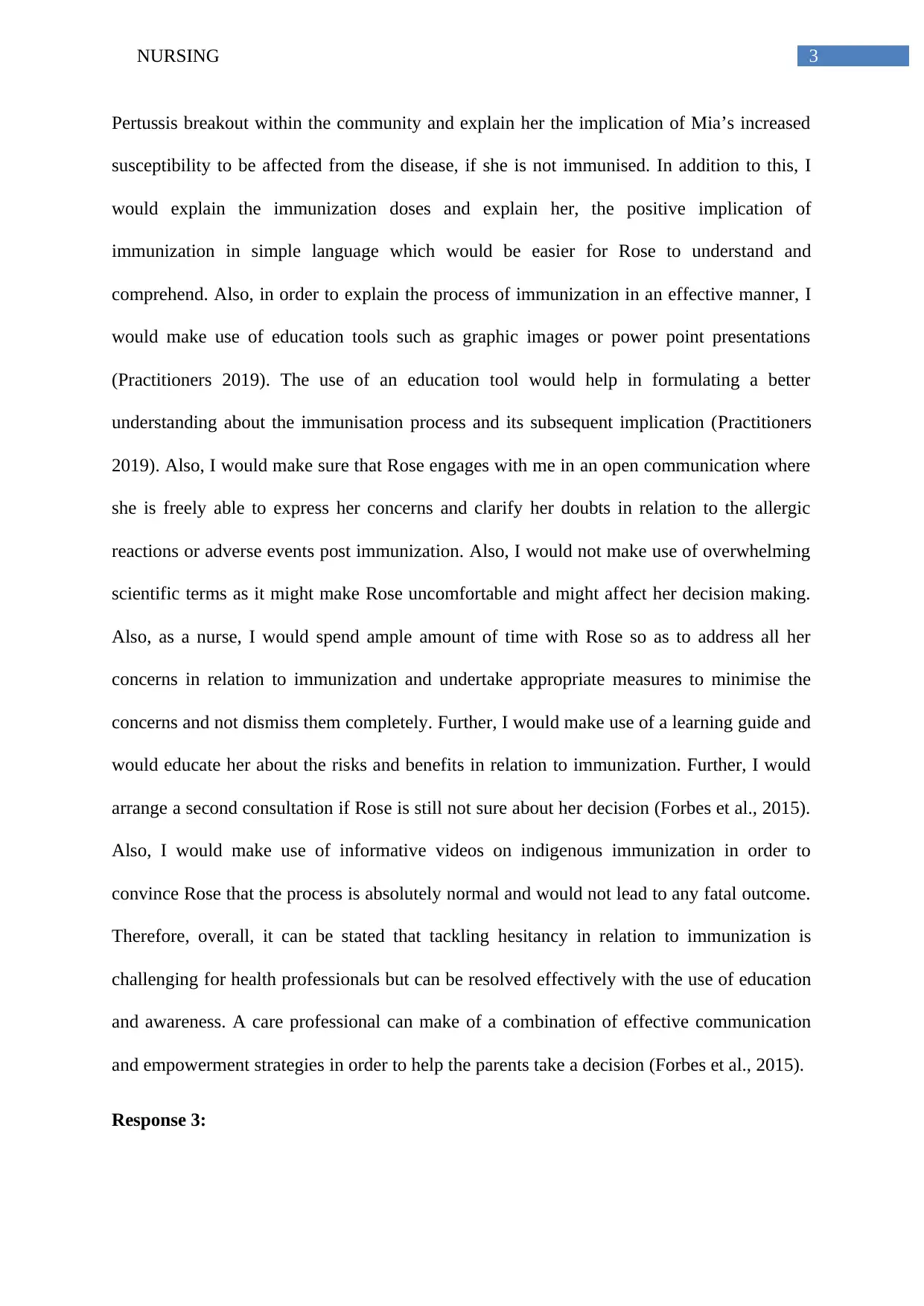
3NURSING
Pertussis breakout within the community and explain her the implication of Mia’s increased
susceptibility to be affected from the disease, if she is not immunised. In addition to this, I
would explain the immunization doses and explain her, the positive implication of
immunization in simple language which would be easier for Rose to understand and
comprehend. Also, in order to explain the process of immunization in an effective manner, I
would make use of education tools such as graphic images or power point presentations
(Practitioners 2019). The use of an education tool would help in formulating a better
understanding about the immunisation process and its subsequent implication (Practitioners
2019). Also, I would make sure that Rose engages with me in an open communication where
she is freely able to express her concerns and clarify her doubts in relation to the allergic
reactions or adverse events post immunization. Also, I would not make use of overwhelming
scientific terms as it might make Rose uncomfortable and might affect her decision making.
Also, as a nurse, I would spend ample amount of time with Rose so as to address all her
concerns in relation to immunization and undertake appropriate measures to minimise the
concerns and not dismiss them completely. Further, I would make use of a learning guide and
would educate her about the risks and benefits in relation to immunization. Further, I would
arrange a second consultation if Rose is still not sure about her decision (Forbes et al., 2015).
Also, I would make use of informative videos on indigenous immunization in order to
convince Rose that the process is absolutely normal and would not lead to any fatal outcome.
Therefore, overall, it can be stated that tackling hesitancy in relation to immunization is
challenging for health professionals but can be resolved effectively with the use of education
and awareness. A care professional can make of a combination of effective communication
and empowerment strategies in order to help the parents take a decision (Forbes et al., 2015).
Response 3:
Pertussis breakout within the community and explain her the implication of Mia’s increased
susceptibility to be affected from the disease, if she is not immunised. In addition to this, I
would explain the immunization doses and explain her, the positive implication of
immunization in simple language which would be easier for Rose to understand and
comprehend. Also, in order to explain the process of immunization in an effective manner, I
would make use of education tools such as graphic images or power point presentations
(Practitioners 2019). The use of an education tool would help in formulating a better
understanding about the immunisation process and its subsequent implication (Practitioners
2019). Also, I would make sure that Rose engages with me in an open communication where
she is freely able to express her concerns and clarify her doubts in relation to the allergic
reactions or adverse events post immunization. Also, I would not make use of overwhelming
scientific terms as it might make Rose uncomfortable and might affect her decision making.
Also, as a nurse, I would spend ample amount of time with Rose so as to address all her
concerns in relation to immunization and undertake appropriate measures to minimise the
concerns and not dismiss them completely. Further, I would make use of a learning guide and
would educate her about the risks and benefits in relation to immunization. Further, I would
arrange a second consultation if Rose is still not sure about her decision (Forbes et al., 2015).
Also, I would make use of informative videos on indigenous immunization in order to
convince Rose that the process is absolutely normal and would not lead to any fatal outcome.
Therefore, overall, it can be stated that tackling hesitancy in relation to immunization is
challenging for health professionals but can be resolved effectively with the use of education
and awareness. A care professional can make of a combination of effective communication
and empowerment strategies in order to help the parents take a decision (Forbes et al., 2015).
Response 3:
Secure Best Marks with AI Grader
Need help grading? Try our AI Grader for instant feedback on your assignments.

4NURSING
According to the World Health Organization (2019), Anaphylaxis has been defines as
a rare allergic reaction that manifests itself post immunization and can turn out to be fatal if
not managed appropriately. The condition generally manifests itself once in a million
vaccines. It should be noted in this context that the condition arises on account of the
interaction taking place between the vaccine antigens and the associated components (Regan
et al.2015). The reactions can either be local as well as systemic and can lead to mild or
severe anaphylactic responses. Allergic reactions can lead to symptoms such as wheezing,
swelling of the throat or the mouth, breathing distress, hypotension, shock or even gene
realized urticarial or hives (Melbourne, 2019). According to the Australian clinical
guidelines, anaphylaxis can be treated with the help of intra-muscular adrenaline
10micrograms/kg or 0.01ml/kg of 1:1000 (a maximum of 0.5ml) into the lateral thigh (Cheng
et al. 2015). The medication should be repeated post 5 minutes, if the condition of the child is
not improving. Further, the nurse must make sure that the infant does not stand up or attempt
to walk (Cheng et al. 2015).
I would carefully assess Mia to detect symptoms of flushing, pruritus, urticarial or
generalised angioedema. Research studies suggest that approximately 20% of the patients do
not exhibit symptoms related to skin allergies (Corben and Leask2016). However, I would
pay attention to the skin-related changes and would also consider other symptoms such as
stridor, wheezing, abdominal vomiting, wheezing, dyspnea, cyanosis or increased respiratory
rate. Upon identifying any of the confirmatory symptoms mentioned above, I would make
use of an appropriate intervention. I would use Adrenaline as a therapeutic intervention as it
has been recommended as the most appropriate intervention strategy that helps in the
management of anaphylaxis (Cheng et al. 2015). The effectiveness of the treatment
intervention can be explained by its ability to act on multiple receptors. The rationale of
going ahead with the treatment would include ensuring constriction of the blood vessels. This
According to the World Health Organization (2019), Anaphylaxis has been defines as
a rare allergic reaction that manifests itself post immunization and can turn out to be fatal if
not managed appropriately. The condition generally manifests itself once in a million
vaccines. It should be noted in this context that the condition arises on account of the
interaction taking place between the vaccine antigens and the associated components (Regan
et al.2015). The reactions can either be local as well as systemic and can lead to mild or
severe anaphylactic responses. Allergic reactions can lead to symptoms such as wheezing,
swelling of the throat or the mouth, breathing distress, hypotension, shock or even gene
realized urticarial or hives (Melbourne, 2019). According to the Australian clinical
guidelines, anaphylaxis can be treated with the help of intra-muscular adrenaline
10micrograms/kg or 0.01ml/kg of 1:1000 (a maximum of 0.5ml) into the lateral thigh (Cheng
et al. 2015). The medication should be repeated post 5 minutes, if the condition of the child is
not improving. Further, the nurse must make sure that the infant does not stand up or attempt
to walk (Cheng et al. 2015).
I would carefully assess Mia to detect symptoms of flushing, pruritus, urticarial or
generalised angioedema. Research studies suggest that approximately 20% of the patients do
not exhibit symptoms related to skin allergies (Corben and Leask2016). However, I would
pay attention to the skin-related changes and would also consider other symptoms such as
stridor, wheezing, abdominal vomiting, wheezing, dyspnea, cyanosis or increased respiratory
rate. Upon identifying any of the confirmatory symptoms mentioned above, I would make
use of an appropriate intervention. I would use Adrenaline as a therapeutic intervention as it
has been recommended as the most appropriate intervention strategy that helps in the
management of anaphylaxis (Cheng et al. 2015). The effectiveness of the treatment
intervention can be explained by its ability to act on multiple receptors. The rationale of
going ahead with the treatment would include ensuring constriction of the blood vessels. This

5NURSING
would facilitate reduction of swelling and would also help in elevating the blood pressure.
This would subsequently lead to effective tackling of the anaphylactic symptoms (Australian
Government Department of Health 2019).
Also, I would consider assess Mia’s airway and would make use of appropriate
interventions. On detecting a potential obstruction of the airway, I would arrange of
immediate intubation. Intubation would help in clearing airway obstruction and prevention of
angioedema (Forbes et al. 2015). I would have to analyse the situation critically and would
need to take an effective clinical decision. Also, intubation must be done with professional
expertise, therefore, I would be extremely cautious while conducting the research. Also, I
would order for a urine test and continuously monitor the vital signs of the infant so as to
evaluate the outcome of the applied intervention strategies. This would also help me in
developing an idea about the progress of the infant and on detecting any abnormality I would
consider changing the applied intervention strategy so as to achieve positive outcome for the
Mia and effectively manage her anaphylactic symptoms.
Response 4:
Following AETI, I would advise Rose to be prepared about any potential adverse
outcome. I would inform both the parents about the adverse allergic reactions that might
occur and educate them to be ready to face the situation. I would inform them to immediately
refer Mia to the adverse events clinic if either of them notice any symptoms in relation to
anaphylaxis mentioned above. I would advise them to be make the baby lie down at her back
and ask them to be prepared with an anaphylaxis kit (Australian Government Department of
Health 2019). I would educate the parents about the immediate anaphylaxis prevention steps,
such as educate them to loosen the tight clothing of the infant and cover the infant with a
blanket. I would also advise them not to offer the baby anything to drink. Also, I would ask
would facilitate reduction of swelling and would also help in elevating the blood pressure.
This would subsequently lead to effective tackling of the anaphylactic symptoms (Australian
Government Department of Health 2019).
Also, I would consider assess Mia’s airway and would make use of appropriate
interventions. On detecting a potential obstruction of the airway, I would arrange of
immediate intubation. Intubation would help in clearing airway obstruction and prevention of
angioedema (Forbes et al. 2015). I would have to analyse the situation critically and would
need to take an effective clinical decision. Also, intubation must be done with professional
expertise, therefore, I would be extremely cautious while conducting the research. Also, I
would order for a urine test and continuously monitor the vital signs of the infant so as to
evaluate the outcome of the applied intervention strategies. This would also help me in
developing an idea about the progress of the infant and on detecting any abnormality I would
consider changing the applied intervention strategy so as to achieve positive outcome for the
Mia and effectively manage her anaphylactic symptoms.
Response 4:
Following AETI, I would advise Rose to be prepared about any potential adverse
outcome. I would inform both the parents about the adverse allergic reactions that might
occur and educate them to be ready to face the situation. I would inform them to immediately
refer Mia to the adverse events clinic if either of them notice any symptoms in relation to
anaphylaxis mentioned above. I would advise them to be make the baby lie down at her back
and ask them to be prepared with an anaphylaxis kit (Australian Government Department of
Health 2019). I would educate the parents about the immediate anaphylaxis prevention steps,
such as educate them to loosen the tight clothing of the infant and cover the infant with a
blanket. I would also advise them not to offer the baby anything to drink. Also, I would ask
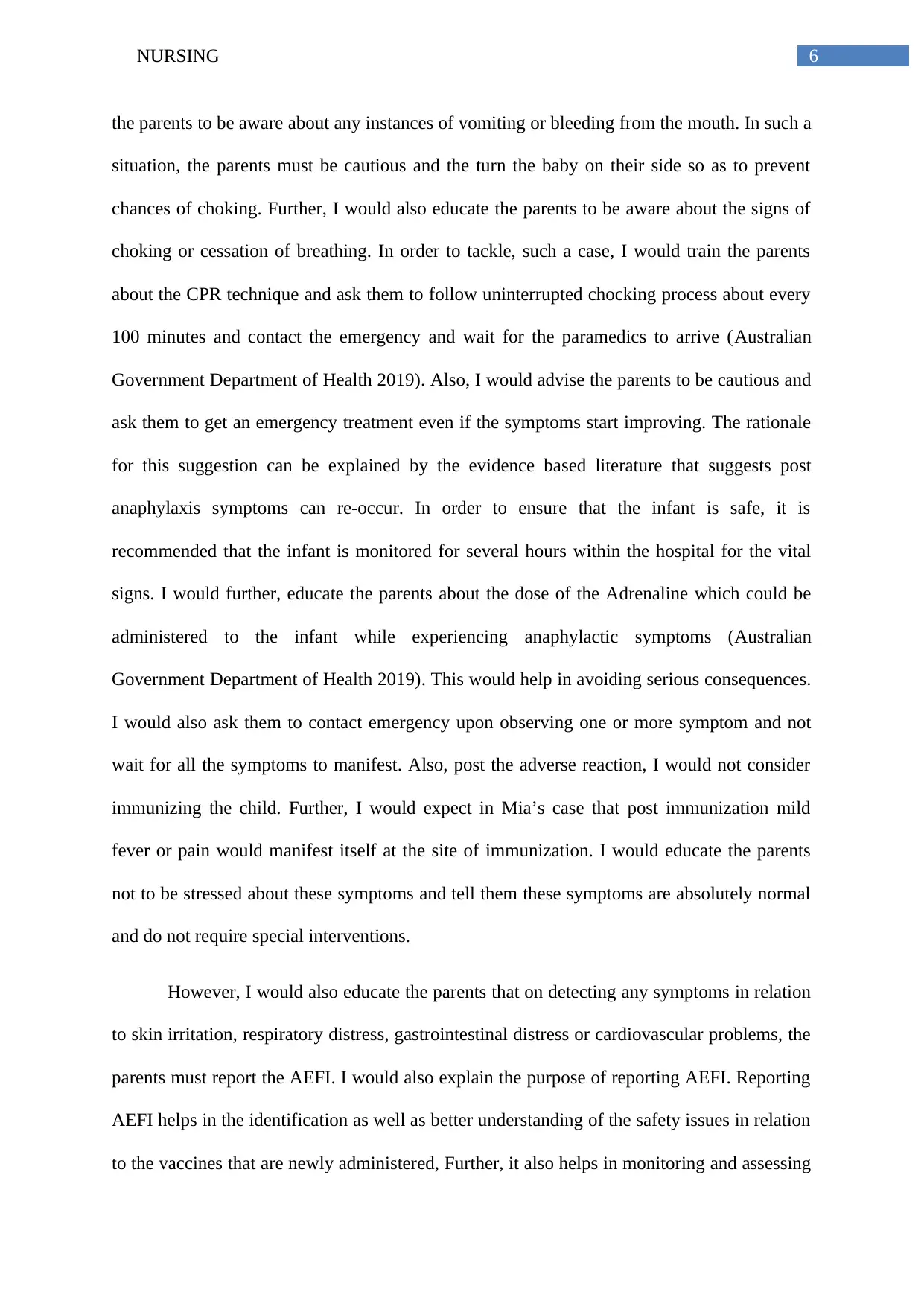
6NURSING
the parents to be aware about any instances of vomiting or bleeding from the mouth. In such a
situation, the parents must be cautious and the turn the baby on their side so as to prevent
chances of choking. Further, I would also educate the parents to be aware about the signs of
choking or cessation of breathing. In order to tackle, such a case, I would train the parents
about the CPR technique and ask them to follow uninterrupted chocking process about every
100 minutes and contact the emergency and wait for the paramedics to arrive (Australian
Government Department of Health 2019). Also, I would advise the parents to be cautious and
ask them to get an emergency treatment even if the symptoms start improving. The rationale
for this suggestion can be explained by the evidence based literature that suggests post
anaphylaxis symptoms can re-occur. In order to ensure that the infant is safe, it is
recommended that the infant is monitored for several hours within the hospital for the vital
signs. I would further, educate the parents about the dose of the Adrenaline which could be
administered to the infant while experiencing anaphylactic symptoms (Australian
Government Department of Health 2019). This would help in avoiding serious consequences.
I would also ask them to contact emergency upon observing one or more symptom and not
wait for all the symptoms to manifest. Also, post the adverse reaction, I would not consider
immunizing the child. Further, I would expect in Mia’s case that post immunization mild
fever or pain would manifest itself at the site of immunization. I would educate the parents
not to be stressed about these symptoms and tell them these symptoms are absolutely normal
and do not require special interventions.
However, I would also educate the parents that on detecting any symptoms in relation
to skin irritation, respiratory distress, gastrointestinal distress or cardiovascular problems, the
parents must report the AEFI. I would also explain the purpose of reporting AEFI. Reporting
AEFI helps in the identification as well as better understanding of the safety issues in relation
to the vaccines that are newly administered, Further, it also helps in monitoring and assessing
the parents to be aware about any instances of vomiting or bleeding from the mouth. In such a
situation, the parents must be cautious and the turn the baby on their side so as to prevent
chances of choking. Further, I would also educate the parents to be aware about the signs of
choking or cessation of breathing. In order to tackle, such a case, I would train the parents
about the CPR technique and ask them to follow uninterrupted chocking process about every
100 minutes and contact the emergency and wait for the paramedics to arrive (Australian
Government Department of Health 2019). Also, I would advise the parents to be cautious and
ask them to get an emergency treatment even if the symptoms start improving. The rationale
for this suggestion can be explained by the evidence based literature that suggests post
anaphylaxis symptoms can re-occur. In order to ensure that the infant is safe, it is
recommended that the infant is monitored for several hours within the hospital for the vital
signs. I would further, educate the parents about the dose of the Adrenaline which could be
administered to the infant while experiencing anaphylactic symptoms (Australian
Government Department of Health 2019). This would help in avoiding serious consequences.
I would also ask them to contact emergency upon observing one or more symptom and not
wait for all the symptoms to manifest. Also, post the adverse reaction, I would not consider
immunizing the child. Further, I would expect in Mia’s case that post immunization mild
fever or pain would manifest itself at the site of immunization. I would educate the parents
not to be stressed about these symptoms and tell them these symptoms are absolutely normal
and do not require special interventions.
However, I would also educate the parents that on detecting any symptoms in relation
to skin irritation, respiratory distress, gastrointestinal distress or cardiovascular problems, the
parents must report the AEFI. I would also explain the purpose of reporting AEFI. Reporting
AEFI helps in the identification as well as better understanding of the safety issues in relation
to the vaccines that are newly administered, Further, it also helps in monitoring and assessing
Paraphrase This Document
Need a fresh take? Get an instant paraphrase of this document with our AI Paraphraser
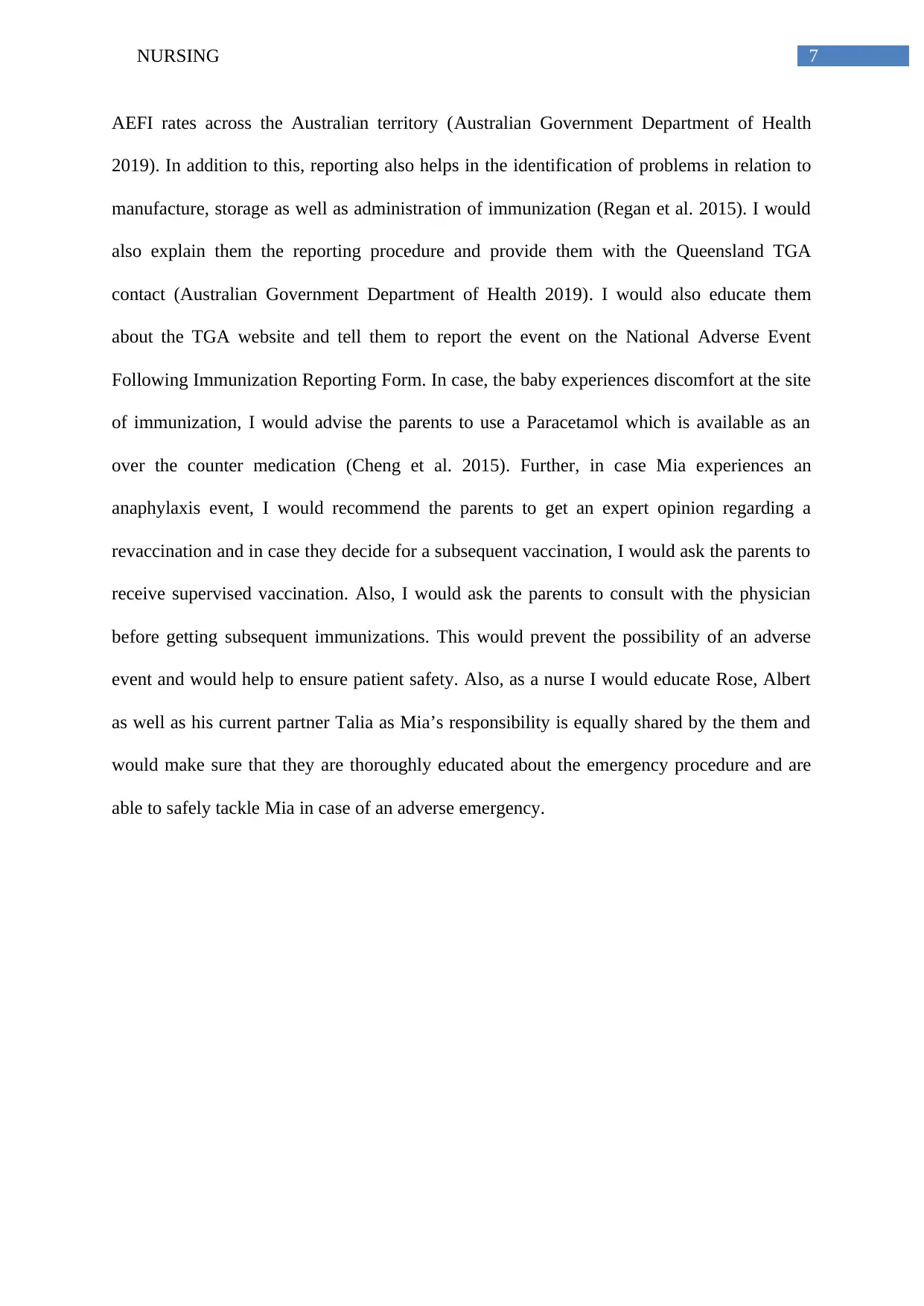
7NURSING
AEFI rates across the Australian territory (Australian Government Department of Health
2019). In addition to this, reporting also helps in the identification of problems in relation to
manufacture, storage as well as administration of immunization (Regan et al. 2015). I would
also explain them the reporting procedure and provide them with the Queensland TGA
contact (Australian Government Department of Health 2019). I would also educate them
about the TGA website and tell them to report the event on the National Adverse Event
Following Immunization Reporting Form. In case, the baby experiences discomfort at the site
of immunization, I would advise the parents to use a Paracetamol which is available as an
over the counter medication (Cheng et al. 2015). Further, in case Mia experiences an
anaphylaxis event, I would recommend the parents to get an expert opinion regarding a
revaccination and in case they decide for a subsequent vaccination, I would ask the parents to
receive supervised vaccination. Also, I would ask the parents to consult with the physician
before getting subsequent immunizations. This would prevent the possibility of an adverse
event and would help to ensure patient safety. Also, as a nurse I would educate Rose, Albert
as well as his current partner Talia as Mia’s responsibility is equally shared by the them and
would make sure that they are thoroughly educated about the emergency procedure and are
able to safely tackle Mia in case of an adverse emergency.
AEFI rates across the Australian territory (Australian Government Department of Health
2019). In addition to this, reporting also helps in the identification of problems in relation to
manufacture, storage as well as administration of immunization (Regan et al. 2015). I would
also explain them the reporting procedure and provide them with the Queensland TGA
contact (Australian Government Department of Health 2019). I would also educate them
about the TGA website and tell them to report the event on the National Adverse Event
Following Immunization Reporting Form. In case, the baby experiences discomfort at the site
of immunization, I would advise the parents to use a Paracetamol which is available as an
over the counter medication (Cheng et al. 2015). Further, in case Mia experiences an
anaphylaxis event, I would recommend the parents to get an expert opinion regarding a
revaccination and in case they decide for a subsequent vaccination, I would ask the parents to
receive supervised vaccination. Also, I would ask the parents to consult with the physician
before getting subsequent immunizations. This would prevent the possibility of an adverse
event and would help to ensure patient safety. Also, as a nurse I would educate Rose, Albert
as well as his current partner Talia as Mia’s responsibility is equally shared by the them and
would make sure that they are thoroughly educated about the emergency procedure and are
able to safely tackle Mia in case of an adverse emergency.
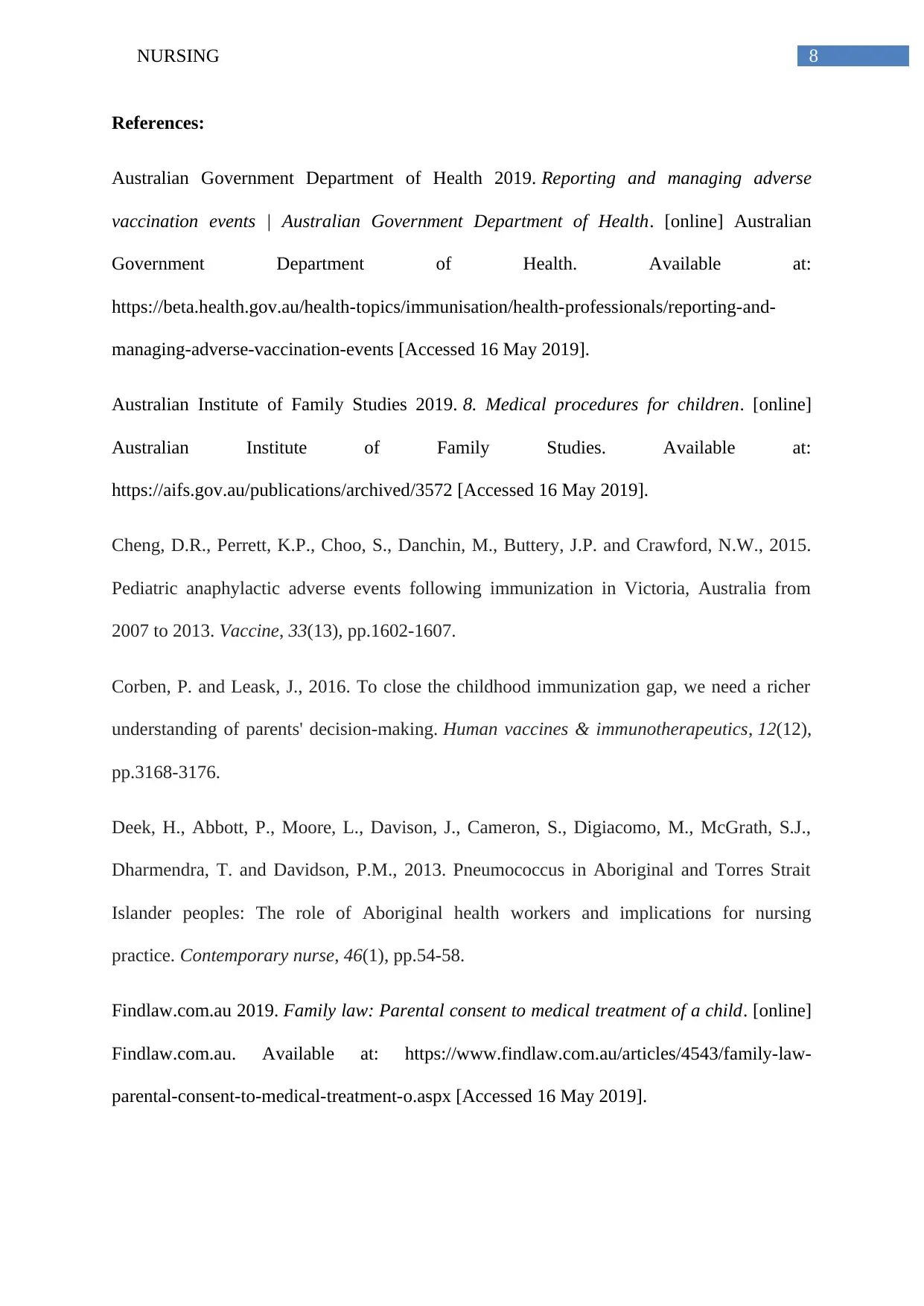
8NURSING
References:
Australian Government Department of Health 2019. Reporting and managing adverse
vaccination events | Australian Government Department of Health. [online] Australian
Government Department of Health. Available at:
https://beta.health.gov.au/health-topics/immunisation/health-professionals/reporting-and-
managing-adverse-vaccination-events [Accessed 16 May 2019].
Australian Institute of Family Studies 2019. 8. Medical procedures for children. [online]
Australian Institute of Family Studies. Available at:
https://aifs.gov.au/publications/archived/3572 [Accessed 16 May 2019].
Cheng, D.R., Perrett, K.P., Choo, S., Danchin, M., Buttery, J.P. and Crawford, N.W., 2015.
Pediatric anaphylactic adverse events following immunization in Victoria, Australia from
2007 to 2013. Vaccine, 33(13), pp.1602-1607.
Corben, P. and Leask, J., 2016. To close the childhood immunization gap, we need a richer
understanding of parents' decision-making. Human vaccines & immunotherapeutics, 12(12),
pp.3168-3176.
Deek, H., Abbott, P., Moore, L., Davison, J., Cameron, S., Digiacomo, M., McGrath, S.J.,
Dharmendra, T. and Davidson, P.M., 2013. Pneumococcus in Aboriginal and Torres Strait
Islander peoples: The role of Aboriginal health workers and implications for nursing
practice. Contemporary nurse, 46(1), pp.54-58.
Findlaw.com.au 2019. Family law: Parental consent to medical treatment of a child. [online]
Findlaw.com.au. Available at: https://www.findlaw.com.au/articles/4543/family-law-
parental-consent-to-medical-treatment-o.aspx [Accessed 16 May 2019].
References:
Australian Government Department of Health 2019. Reporting and managing adverse
vaccination events | Australian Government Department of Health. [online] Australian
Government Department of Health. Available at:
https://beta.health.gov.au/health-topics/immunisation/health-professionals/reporting-and-
managing-adverse-vaccination-events [Accessed 16 May 2019].
Australian Institute of Family Studies 2019. 8. Medical procedures for children. [online]
Australian Institute of Family Studies. Available at:
https://aifs.gov.au/publications/archived/3572 [Accessed 16 May 2019].
Cheng, D.R., Perrett, K.P., Choo, S., Danchin, M., Buttery, J.P. and Crawford, N.W., 2015.
Pediatric anaphylactic adverse events following immunization in Victoria, Australia from
2007 to 2013. Vaccine, 33(13), pp.1602-1607.
Corben, P. and Leask, J., 2016. To close the childhood immunization gap, we need a richer
understanding of parents' decision-making. Human vaccines & immunotherapeutics, 12(12),
pp.3168-3176.
Deek, H., Abbott, P., Moore, L., Davison, J., Cameron, S., Digiacomo, M., McGrath, S.J.,
Dharmendra, T. and Davidson, P.M., 2013. Pneumococcus in Aboriginal and Torres Strait
Islander peoples: The role of Aboriginal health workers and implications for nursing
practice. Contemporary nurse, 46(1), pp.54-58.
Findlaw.com.au 2019. Family law: Parental consent to medical treatment of a child. [online]
Findlaw.com.au. Available at: https://www.findlaw.com.au/articles/4543/family-law-
parental-consent-to-medical-treatment-o.aspx [Accessed 16 May 2019].
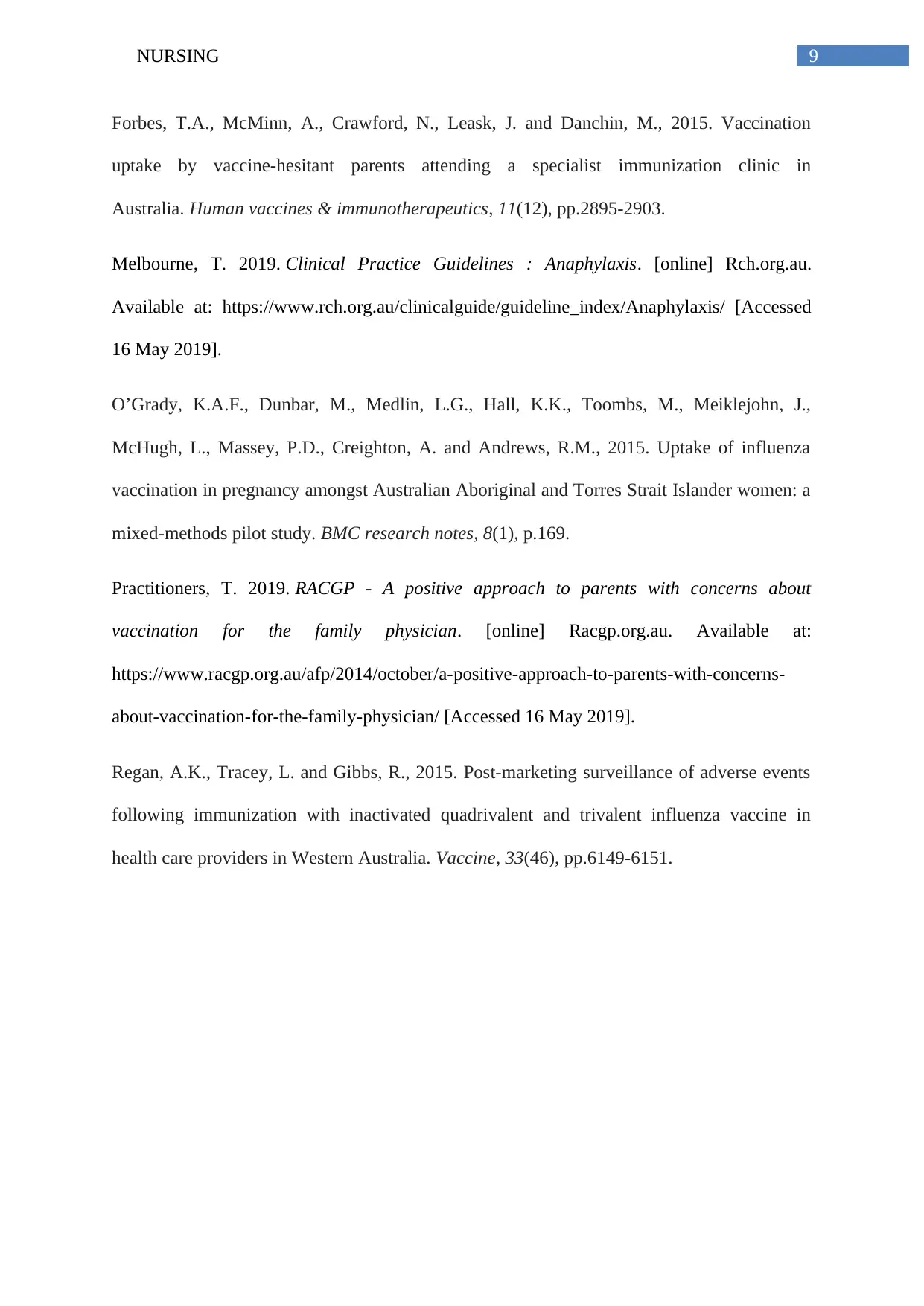
9NURSING
Forbes, T.A., McMinn, A., Crawford, N., Leask, J. and Danchin, M., 2015. Vaccination
uptake by vaccine-hesitant parents attending a specialist immunization clinic in
Australia. Human vaccines & immunotherapeutics, 11(12), pp.2895-2903.
Melbourne, T. 2019. Clinical Practice Guidelines : Anaphylaxis. [online] Rch.org.au.
Available at: https://www.rch.org.au/clinicalguide/guideline_index/Anaphylaxis/ [Accessed
16 May 2019].
O’Grady, K.A.F., Dunbar, M., Medlin, L.G., Hall, K.K., Toombs, M., Meiklejohn, J.,
McHugh, L., Massey, P.D., Creighton, A. and Andrews, R.M., 2015. Uptake of influenza
vaccination in pregnancy amongst Australian Aboriginal and Torres Strait Islander women: a
mixed-methods pilot study. BMC research notes, 8(1), p.169.
Practitioners, T. 2019. RACGP - A positive approach to parents with concerns about
vaccination for the family physician. [online] Racgp.org.au. Available at:
https://www.racgp.org.au/afp/2014/october/a-positive-approach-to-parents-with-concerns-
about-vaccination-for-the-family-physician/ [Accessed 16 May 2019].
Regan, A.K., Tracey, L. and Gibbs, R., 2015. Post-marketing surveillance of adverse events
following immunization with inactivated quadrivalent and trivalent influenza vaccine in
health care providers in Western Australia. Vaccine, 33(46), pp.6149-6151.
Forbes, T.A., McMinn, A., Crawford, N., Leask, J. and Danchin, M., 2015. Vaccination
uptake by vaccine-hesitant parents attending a specialist immunization clinic in
Australia. Human vaccines & immunotherapeutics, 11(12), pp.2895-2903.
Melbourne, T. 2019. Clinical Practice Guidelines : Anaphylaxis. [online] Rch.org.au.
Available at: https://www.rch.org.au/clinicalguide/guideline_index/Anaphylaxis/ [Accessed
16 May 2019].
O’Grady, K.A.F., Dunbar, M., Medlin, L.G., Hall, K.K., Toombs, M., Meiklejohn, J.,
McHugh, L., Massey, P.D., Creighton, A. and Andrews, R.M., 2015. Uptake of influenza
vaccination in pregnancy amongst Australian Aboriginal and Torres Strait Islander women: a
mixed-methods pilot study. BMC research notes, 8(1), p.169.
Practitioners, T. 2019. RACGP - A positive approach to parents with concerns about
vaccination for the family physician. [online] Racgp.org.au. Available at:
https://www.racgp.org.au/afp/2014/october/a-positive-approach-to-parents-with-concerns-
about-vaccination-for-the-family-physician/ [Accessed 16 May 2019].
Regan, A.K., Tracey, L. and Gibbs, R., 2015. Post-marketing surveillance of adverse events
following immunization with inactivated quadrivalent and trivalent influenza vaccine in
health care providers in Western Australia. Vaccine, 33(46), pp.6149-6151.
1 out of 10
Your All-in-One AI-Powered Toolkit for Academic Success.
+13062052269
info@desklib.com
Available 24*7 on WhatsApp / Email
![[object Object]](/_next/static/media/star-bottom.7253800d.svg)
Unlock your academic potential
© 2024 | Zucol Services PVT LTD | All rights reserved.


